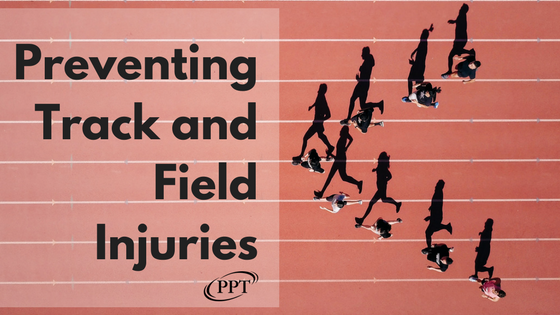Preventing Track and Field Injuries
Track and field may not be a contact sport but injuries still happen. Track and field offers a large variety of events for athletes to participate in from running to throwing to jumping. Each of these events can lead to different injuries and many track athletes are plagued with overuse injuries at some point in their careers. The good news is, there are many things athletes can do to help prevent getting hurt. As a current track and field athlete, myself, I have seen many of my teammates have to deal with season ending injuries, and unfortunately learning how to prevent injuries isn’t usually talked about until it is too late. Below are some of the injuries you may be at risk for based on your events, and some simple steps you can take to reduce your risk for injury.
Running:
Track and field running events are split into 3 categories: long distance, mid-distance and sprints. Distance runners require cardiovascular endurance in order to perform their best. Mid-distance running requires speed, cardiovascular endurance, and stamina. Sprinters need speed and power. Each category of running puts stress on an athlete’s body and can lead to injury.
Common injuries:
Lower extremity stress reactions/fractures
Achilles tendonitis/Achilles Tendon Ruptures
IT band strains (Long Distance)
Bursitis of the knee (Sprinters)
Hamstring Strains (Sprinters)
Hip impingement/hip labral tears
Jumping:
There are four jumping events in track: long jump, triple jump, high jump and pole vault. All jumpers require lower body power, core strength, flexibility, and speed. Jumpers must have good control over their bodies and understand how to properly land. Jumpers also are at risk for different injuries.
Common injuries:
Stress Reaction/Fractures
ACL Stains/Tears
Bursitis
Achilles Tendonitis
Throwing:
There are four different throwing events in track: javelin, shot put, discus and hammer. All throwing events require strength, speed, power, flexibility, and balance. Throwing can commonly lead to more injuries in the upper extremities.
Common injuries:
Shoulder impingement/shoulder labral tears
Shoulder Bursitis
Spondylolysis (Javelin throwers)
Ulnar Collateral Ligament (UCL) tears of the elbow
Rotator Cuff Injury
How to prevent Track and Field Injuries?
There are many different techniques to help track and field athletes stay healthy. Here are 8 easy ways to prevent injuries in track and field.
Properly fitting shoes:
The correct fitting shoe should help keep an athlete’s ankle joint is stable, and can help with absorbing the high ground reaction forces. A good rule of thumb is to get new sneakers every 300-500 miles or every new season.
Proper Warm-Up:
Warm-ups should include dynamic stretches that are specific for the athlete’s event. A thrower’s warm up should be different from a jumper’s warm up.
Periodization:
For runners the volume, duration and intensity should be gradually increase 5-10% per week. With all track and field athletes training should start off slowly and increase as the season goes on. It is good to switch up workouts and make sure rest weeks are given to keep an athlete healthy.
Gait Analysis:
Having track and field gait looked at can help prevent different injuries especially in distance runners. Gait analysis can also help with athletes coming back from injuries.
Strength Training:
Strength training is a great way to prevent injuries in track athletes. All track and field athletes should do exercises appropriate to their event. A distance runner shouldn’t have the same strength plan as a thrower.
Correct form:
Athletes should be aware of correct form for their events. Not having correct form can lead to injuries. The more athletes work on technique the better.
Proper Cool down:
All athletes should take time after their workouts to properly stretch and foam roll out. Each static stretch should be held for 30 seconds. Foam rolling can also be used to help cool down. The foam roller can be used on the hamstrings, quads, calves, back muscles, IT bands, and glutes.
Stay hydrated and eat a balanced diet:
Take in 6-8 ounces of fluids every 15-20 minutes of exercise. Track and field athletes should eat a balanced diet filled with protein, fruits, vegetables, and dairy. Athletes should be aware that they are burning calories during practice and in order to perform their best must replenish what they lose during workouts.

